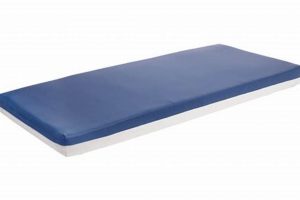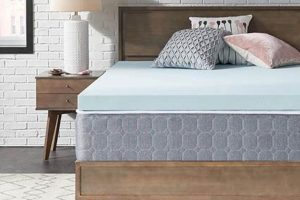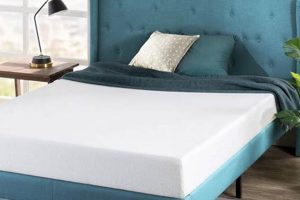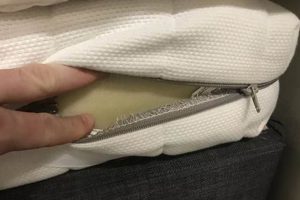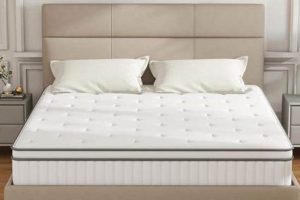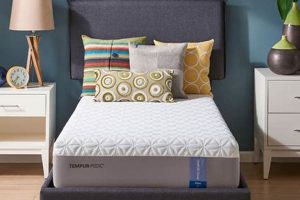A bed configuration consisting of two separate mattresses, each the size of a twin extra-long, placed side-by-side to form a sleeping surface equivalent to a king-size bed. These mattresses are constructed primarily from visco-elastic foam, known for its pressure-relieving and conforming properties. This design is frequently selected to accommodate individual sleep preferences and needs within a shared bed.
The appeal of this bed setup lies in its capacity to minimize motion transfer, ensuring that movement on one side does not significantly disturb the other sleeper. This feature proves particularly beneficial for couples with differing sleep schedules or those prone to tossing and turning during the night. Furthermore, the independent adjustability offered by this system, when paired with adjustable bed frames, provides personalized comfort and support, potentially alleviating pressure points and promoting spinal alignment. The advent of this configuration addresses the growing demand for customized sleep solutions that cater to individual requirements within a shared sleeping space.
Having established a foundational understanding of this particular type of bed, the following sections will delve into specific aspects such as the advantages of its use, considerations for selecting the optimal model, and relevant factors pertaining to its maintenance and longevity. These topics will provide a more comprehensive view, aiding informed decision-making.
Selecting the appropriate split king memory foam mattress necessitates careful consideration of several factors. The subsequent tips are designed to provide guidance in this process, ensuring a well-informed decision.
Tip 1: Evaluate Density and ILD Rating: Density, measured in pounds per cubic foot, indicates the foam’s durability and support. Higher density foams generally offer greater longevity. The Indentation Load Deflection (ILD) rating reflects the foam’s firmness; a lower ILD corresponds to a softer feel. Consider individual preferences and sleep positions when assessing these metrics.
Tip 2: Assess Layer Construction: Examine the composition of the mattress layers. A typical configuration includes a comfort layer of memory foam, a transition layer for support, and a high-density base layer for stability. The quality and arrangement of these layers significantly impact overall comfort and support.
Tip 3: Consider Cooling Technologies: Memory foam can retain heat. Look for mattresses incorporating cooling technologies such as gel infusions, open-cell structures, or breathable covers. These features can mitigate heat buildup and promote a more comfortable sleep environment.
Tip 4: Verify Certifications: Seek mattresses certified by independent organizations such as CertiPUR-US. This certification ensures that the foam has been tested for harmful substances, volatile organic compounds (VOCs), and emissions, promoting safer indoor air quality.
Tip 5: Research Edge Support: Edge support refers to the stability of the mattress perimeter. Strong edge support prevents sagging and provides a consistent sleep surface across the entire mattress, maximizing usable space.
Tip 6: Scrutinize Warranty and Trial Period: A comprehensive warranty protects against manufacturing defects and premature sagging. A sufficient trial period allows for testing the mattress at home, ensuring it meets individual comfort preferences and support needs.
Tip 7: Read Reviews Extensively: Consult multiple sources of customer reviews to gain insights into real-world experiences with the mattress’s comfort, durability, and performance. Pay attention to recurring themes and address any concerns with the manufacturer or retailer.
By carefully considering these elements, an informed selection of this particular mattress type can be made, leading to optimized sleep quality and long-term satisfaction.
With these targeted guidelines addressed, the article will now shift to a conclusive summary.
1. Motion Isolation
Motion isolation, referring to the capacity of a mattress to absorb movement on one area and prevent its transmission to other areas, is a critical feature inherently linked to the split king memory foam mattress. The design, comprising two independently functioning mattresses, intrinsically contributes to enhanced motion isolation compared to a single, continuous king-size mattress. This reduction in motion transfer is primarily attributable to the separation between the two individual sleeping surfaces and the inherent properties of memory foam. Memory foam’s visco-elastic nature enables it to compress and conform to pressure without significantly affecting adjacent areas. For example, if one partner shifts position or gets out of bed, the disturbance is largely confined to their individual mattress, minimizing the likelihood of disrupting the sleep of the other partner. This stands in contrast to innerspring mattresses, where interconnected coils often transmit movement across the entire surface.
The effectiveness of motion isolation is further amplified by the composition and construction of the memory foam itself. Higher density memory foam, as previously noted, tends to exhibit superior motion isolation capabilities due to its greater capacity for absorbing and dissipating energy. Additionally, specific manufacturing techniques, such as zoning the foam into different densities across the mattress, can further enhance motion isolation by providing targeted support and minimizing ripple effects from movement. In practical terms, couples with differing sleep schedules, restless sleepers, or individuals susceptible to sleep disturbances find significant benefit from the motion isolation properties inherent to the this setup. By isolating movement, the split king memory foam mattress fosters a more restful and undisturbed sleep environment for both partners.
In summary, the inherent design of the split king memory foam mattress, combined with the material properties of memory foam, significantly enhances motion isolation. This pivotal feature reduces sleep disturbances and promotes more restful sleep for couples with varying sleep habits or sensitivities to movement. Understanding the relationship between these elements is crucial for consumers seeking to optimize their sleep quality and overall comfort.
2. Adjustable Base Compatibility
Adjustable base compatibility represents a significant consideration when evaluating the functionality and potential benefits of a split king memory foam mattress. The intersection of these two elements provides enhanced personalization and ergonomic support, addressing diverse needs within a shared sleeping space. Compatibility ensures that the mattress conforms appropriately to the ad
justable base’s articulating sections without compromising its structural integrity or comfort properties.
- Independent Adjustment
The primary advantage of combining a split king memory foam mattress with an adjustable base lies in the ability to independently adjust each side of the bed. This feature caters to individual preferences for sleep position and elevation, allowing one partner to sit upright for reading while the other remains reclined. This independent functionality is only achievable with a split king configuration, as a standard king-size mattress would move as a single unit. The implication is a tailored sleep experience addressing unique health concerns, comfort preferences, or lifestyle choices.
- Pressure Relief and Support
Adjustable bases, when paired with memory foam mattresses, facilitate targeted pressure relief and support. Raising the head or feet can alleviate pressure on the lower back, hips, or shoulders. Furthermore, customizable support can reduce pressure that comes with health issues. Memory foam’s conforming properties adapt to the contours of the body, maximizing the benefits of the adjustable base. This synergy provides ergonomic support, potentially alleviating discomfort associated with conditions such as sleep apnea, acid reflux, or back pain.
- Material Flexibility
Memory foam’s inherent flexibility is crucial for successful integration with an adjustable base. Unlike innerspring mattresses, which may resist bending or articulation, memory foam readily conforms to the angles and contours of the adjustable base without compromising its structural integrity. This flexibility ensures that the mattress maintains its shape and support characteristics, even when the base is in various elevated positions. The implication is a more durable and comfortable sleeping surface that withstands the repeated movements of the adjustable base.
- Weight Distribution
Proper weight distribution is essential for both comfort and longevity. It is also important to evenly distribute weight across the surface to minimize stress on any single point. The memory foam construction in a split king configuration allows for optimal conforming and support that goes with pressure to enhance proper spinal alignment, and reduce pressure points. The implications are that this may improve circulation which promotes better rest and decreases pressure.
The convergence of adjustable base compatibility and split king memory foam construction results in a highly customizable and ergonomically supportive sleep system. The ability to independently adjust each side, combined with memory foam’s pressure-relieving properties, offers a tailored sleep experience addressing individual needs and preferences. Compatibility hinges on material flexibility, weight distribution, and overall construction, ensuring that the mattress performs optimally with the adjustable base. Such configurations offer a potentially improved sleeping experience.
3. Individualized Comfort
The split king memory foam mattress configuration directly addresses the growing demand for individualized comfort within a shared sleep environment. Its fundamental design, consisting of two separate mattresses, allows for independent selection of firmness levels and support characteristics on each side of the bed. This decoupling of sleep surfaces acknowledges the reality that individuals often have disparate preferences regarding mattress feel, support requirements dictated by body weight and sleep position, and sensitivity to pressure points. For instance, one partner may prefer a firmer mattress to promote spinal alignment due to back pain, while the other may opt for a softer surface to alleviate pressure on sensitive joints. The split king memory foam mattress makes this type of personalization possible, directly addressing a significant source of sleep compromise in shared beds. The provision of customized comfort is not merely a luxury; it is a practical response to the diverse physiological needs of sleeping individuals.
The impact of individualized comfort extends beyond mere preference. It can have tangible effects on sleep quality and overall well-being. A correctly matched mattress can improve spinal alignment, reduce pressure points, and minimize tossing and turning, leading to more restful and restorative sleep. The availability of independent adjustability, as facilitated by the split king configuration, further enhances these benefits. For example, one partner may elevate their head to alleviate sleep apnea symptoms, while the other maintains a flat sleeping position. This level of customization is not achievable with a traditional king-size mattress. Furthermore, the isolation of movement inherent in the split design minimizes disturbances caused by partner movement, further contributing to improved sleep quality. These practical advantages underscore the importance of individualized comfort as a fundamental component of the split king memory foam mattress, rather than a mere marketing claim.
In summary, the split king memory foam mattress is inextricably linked to the concept of individualized comfort. Its design is specifically engineered to accommodate differing sleep preferences and needs within a shared bed. This ability to customize firmness, support, and sleeping positions translates directly into improved sleep quality and potential health benefits. While challenges remain in selecting the optimal mattress for each individual, the split king configuration represents a significant advancement in addressing the inherent compromises associated with shared sleep, aligning sleep technology with the understanding that comfort is a highly individual experience with significant implications for health and well-being.
4. Temperature Regulation
Temperature regulation within the context of a split king memory foam mattress represents a critical factor influencing sleep quality and overall user satisfaction. Traditional memory foam is known for its heat retention properties, which can lead to discomfort and disrupted sleep cycles for some individuals. Addressing this inherent limitation is paramount in optimizing the performance and appeal of this mattress configuration.
- Material Composition and Airflow
The density and composition of memory foam directly impact its ability to regulate temperature. Denser foams tend to trap more heat due to reduced airflow. Mattress manufacturers employ various techniques to mitigate this issue, including incorporating open-cell structures that promote air circulation, infusing the foam with cooling gels or phase-change materials (PCMs), or using channeled designs to enhance ventilation. The efficacy of these approaches varies, and the specific materials used can significantly influence the mattress’s overall thermal performance.
- Cover Materials and Breathability
The mattress cover plays a vital role in temperature regulation by facilitating moisture wicking and airflow. Covers made from breathable materials such as cotton, bamboo, or specialized performance fabrics can help dissipate heat and prevent the buildup of humidity. Some covers also incorporate cooling technologies or treatments designed to enhance their thermal properties. The cover’s design, weave, and material composition all contribute to its effectiveness in regulatin
g temperature. - Individual Sleep Preferences and Environmental Factors
Perceptions of temperature and comfort are subjective and influenced by individual physiology, sleepwear, and ambient room temperature. Factors such as body weight, metabolic rate, and hormonal fluctuations can affect an individual’s sensitivity to heat. Additionally, the climate and season can significantly impact the effectiveness of temperature regulation measures. A mattress that performs adequately in a cooler environment may prove less effective in a warmer setting, highlighting the importance of considering these variables.
- Split Configuration and Heat Dissipation
The split king design, while primarily intended to address motion isolation and individualized comfort, may also indirectly influence temperature regulation. The separation between the two mattresses can promote better air circulation around each individual sleeping surface, potentially reducing the buildup of heat. Furthermore, the availability of separate adjustable bases allows for customized positioning, which can influence airflow and heat dissipation. The extent to which the split configuration contributes to temperature regulation depends on various factors, including the mattress construction, cover materials, and the individual’s sleeping environment.
In conclusion, temperature regulation is an intrinsic aspect of the split king memory foam mattress, directly influencing user comfort and sleep quality. The effectiveness of temperature regulation is determined by a complex interplay of factors, including the material composition, cover design, individual sleep preferences, and environmental conditions. Mattress manufacturers are continually innovating to address the inherent heat retention properties of memory foam and optimize thermal performance. Prospective buyers should carefully consider these factors when evaluating different mattress models to ensure a comfortable and restful sleep experience.
5. Long-Term Durability
Long-term durability constitutes a significant determinant of value and satisfaction for consumers of split king memory foam mattresses. The initial investment in such a sleep system necessitates an expectation of sustained performance over an extended period. The inherent properties of memory foam, its density, and the overall construction of the mattress directly influence its capacity to withstand prolonged use without significant degradation in support, comfort, or shape. For instance, a high-density memory foam mattress, properly supported by a robust base, is inherently more resistant to sagging and compression over time compared to a lower-density alternative. The selection of appropriate materials and manufacturing processes is therefore paramount in ensuring the longevity of the product.
The split king configuration, while offering advantages in motion isolation and individualized comfort, introduces specific considerations pertaining to durability. The division into two separate mattresses necessitates a uniform distribution of weight across each unit. Inadequate support beneath either mattress can accelerate wear and tear, leading to uneven compression and diminished performance. Furthermore, the repeated articulation of adjustable bases, when paired with split king memory foam mattresses, can exert stress on the foam and seams, potentially compromising their integrity over time. To mitigate these risks, manufacturers must employ durable materials and reinforced construction techniques that can withstand the dynamic forces associated with adjustable bases. Real-world examples of premature mattress failure often stem from inadequate support structures, substandard foam densities, or compromised seams, underscoring the practical importance of scrutinizing these factors during the selection process.
Ultimately, the long-term durability of a split king memory foam mattress is contingent upon a convergence of factors, including material quality, construction techniques, and appropriate support. A comprehensive understanding of these elements empowers consumers to make informed purchasing decisions, maximizing the return on their investment and ensuring sustained comfort and support over the lifespan of the mattress. The challenge lies in discerning genuine quality from superficial marketing claims, necessitating a thorough evaluation of specifications, certifications, and warranty provisions. By prioritizing durability, consumers can mitigate the risks of premature mattress failure and ensure a more restful and cost-effective sleep experience.
6. Customizable Support
Customizable support, in the context of a split king memory foam mattress, addresses the varying physical needs and preferences of individuals sharing a bed. This feature allows for personalized comfort and ergonomic alignment, critical for restorative sleep and mitigating discomfort associated with different body types, sleep positions, or pre-existing conditions.
- Independent Firmness Levels
Independent firmness levels are a primary component of customizable support. The split construction allows each side of the mattress to possess a distinct firmness profile, catering to individual preferences. One partner may prefer a firmer surface for spinal alignment, while the other may require a softer surface for pressure point relief. This independence is vital in accommodating disparate comfort needs within a single sleeping space. The implication of independent firmness lies in the reduction of compromise and the potential for improved sleep quality for both individuals.
- Zoned Support Systems
Zoned support systems involve the incorporation of varying densities or strategically placed support elements within the memory foam layers. These zones target specific areas of the body, such as the lumbar region or shoulders, providing tailored support and pressure relief. For example, a mattress might feature firmer support in the center to prevent spinal misalignment, while offering softer cushioning in the shoulder area to alleviate pressure for side sleepers. The implementation of zoned support enhances ergonomic alignment and reduces discomfort associated with specific sleep positions or physical ailments.
- Adjustable Base Integration
Integration with adjustable bases further enhances customizable support. The split king configuration allows each side of the bed to be independently adjusted, enabling personalized elevation of the head or legs. This feature is particularly beneficial for individuals with medical conditions such as sleep apnea, acid reflux, or back pain, as it allows for customized positioning to alleviate symptoms and promote more comfortable sleep. Adjustable bases, combined with memory foam’s conforming properties, provide a versatile and adaptable sleep surface that caters to individual needs.
- Layer Modification Options
Certain manufacturers offer layer modification options, allowing consumers to customize the internal arrangement of the mattress layers to further fine-tune support and comfort. This may involve swapping out different foam densities or adding specialized inserts to target specific pressure points or support needs. The availability of layer modification options empowers consumers to personalize their sleep surface to an even greater degree, ensuring optimal comfort and su
pport based on individual preferences and requirements.
These facets of customizable support, when effectively implemented within a split king memory foam mattress, can significantly enhance sleep quality and overall satisfaction. The ability to tailor the sleep surface to individual needs addresses the inherent compromises associated with shared beds, promoting a more restful and restorative sleep experience for both individuals. As technology advances, the degree of customization available in split king memory foam mattresses is likely to expand, further enhancing their appeal to consumers seeking personalized sleep solutions.
Frequently Asked Questions
The following questions and answers address common inquiries and misconceptions regarding split king memory foam mattresses. The information presented aims to provide clarity and facilitate informed decision-making.
Question 1: What distinguishes a split king memory foam mattress from a standard king-size mattress?
A split king memory foam mattress consists of two separate twin XL mattresses, each independently constructed from memory foam. A standard king-size mattress is a single, continuous unit. This split configuration allows for independent adjustment and reduced motion transfer.
Question 2: Are specialized sheets required for a split king memory foam mattress?
Yes, specialized sheets are recommended. While a standard king-size fitted sheet will not fit properly, two twin XL fitted sheets can be used. Alternatively, certain manufacturers offer split king sheet sets designed to accommodate the independent mattress design.
Question 3: Does a split king memory foam mattress eliminate motion transfer entirely?
While it significantly reduces motion transfer compared to traditional innerspring mattresses, complete elimination is not guaranteed. The degree of motion isolation depends on the density of the memory foam and the individual’s sensitivity to movement. Higher density foams generally offer greater motion isolation.
Question 4: Is a split king memory foam mattress compatible with all adjustable bed frames?
Compatibility depends on the adjustable bed frame’s design. Frames specifically designed for split king mattresses feature independent adjustability for each side. A standard king-size adjustable frame will not function properly with a split king mattress.
Question 5: What is the typical lifespan of a split king memory foam mattress?
The lifespan varies depending on factors such as foam density, usage patterns, and maintenance. However, with proper care, a high-quality split king memory foam mattress can be expected to last between 7 to 10 years.
Question 6: Does a split king memory foam mattress require special cleaning procedures?
General cleaning guidelines for memory foam mattresses apply. Regular vacuuming helps remove dust and allergens. Stains should be spot-cleaned with a mild detergent and water. Avoid harsh chemicals and excessive moisture.
These FAQs provide a foundational understanding of split king memory foam mattresses. Consideration of these points can aid in evaluating the suitability of this mattress type for individual needs.
With these common queries addressed, the following section will summarize the key considerations for selecting a split king memory foam mattress.
Concluding Summary
This exposition has meticulously examined the split king memory foam mattress, delineating its construction, benefits, and considerations for optimal selection and utilization. The primary advantages, including enhanced motion isolation and individualized comfort, underscore its relevance in shared sleeping environments. Key factors such as foam density, temperature regulation, adjustable base compatibility, and long-term durability must be carefully evaluated to ensure a satisfactory ownership experience.
The decision to invest in a split king memory foam mattress should be predicated on a thorough assessment of individual needs and preferences, coupled with a critical evaluation of product specifications and performance claims. The potential for improved sleep quality and ergonomic support warrants careful consideration, but consumers are cautioned to prioritize objective data and verifiable certifications over unsubstantiated marketing rhetoric. The long-term benefits are contingent upon informed selection and diligent maintenance practices.


